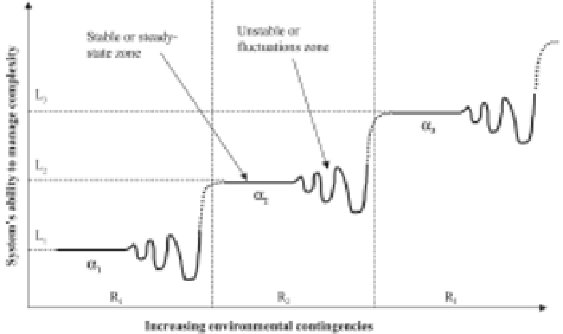Information Technology Reference
In-Depth Information
Figure 11.6. System transformation and production of macroscopic order.
Based on the theory of dissipative structure, the system needs energy from the external
environment to achieve a higher-level state or to be transformed into a new form with
higher complexity and more capability to deal with increased environmental contingen-
cies. In organisational theory, energy can be considered analogous to resources, efforts,
change strategy, leadership, knowledge and information, and power required to effect
fluctuations, which result in a transition from one state to another.
Model synthesis and discussion
The justification for adopting a unified or integrated approach in modelling change and
evolution in organisations comes from the pattern of change characterised by the Theory
of Punctuated Equilibrium, which was originally proposed in the field of palaeontology
and biological evolution in the mid-20th century to explain a discontinuous change of
patterns usually found in fossils (Mayr, 1942, 1982; Gould and Eldredge, 1977; Hoffman,
1989).
Theory of punctuated equilibrium and rationale for model synthesis
It is proposed in the Theory of Punctuated Equilibrium that biological species can remain
unchanged, or only have a marginal change in their form, over a lengthy time period.
This period is called 'stasis'. However, in order to survive and avoid extinction when
the environment becomes unfavourable, the pace of evolutionary change needs to be
accelerated. This results in a relatively discontinuous change in the species form. In
other words, a new species comes into existence. Thus, according to this theory, a pattern
of relatively long and stable periods punctuated by rapid and discontinuous change is
typical of natural biological systems.
A similar pattern of change occurs in organisational dynamics (e.g. Miller and Friesen,
1984; Tushman and Romaneli, 1985, 1994; Gersick, 1988, 1991). As mentioned earlier,
change in organisations is often characterised by a lengthy period of incremental,
gradual and adaptive change (convergence) alternated or punctuated by a short period
of a widespread, discontinuous and transformational change (reorientation). Modelling
both phases of change thus poses a challenge because the traditional open systems
model, which is based on the concepts of homeostasis and steady state, can only describe
and explain the 'stasis' or 'convergence' phase. It does not encompass the type of change

Search WWH ::

Custom Search